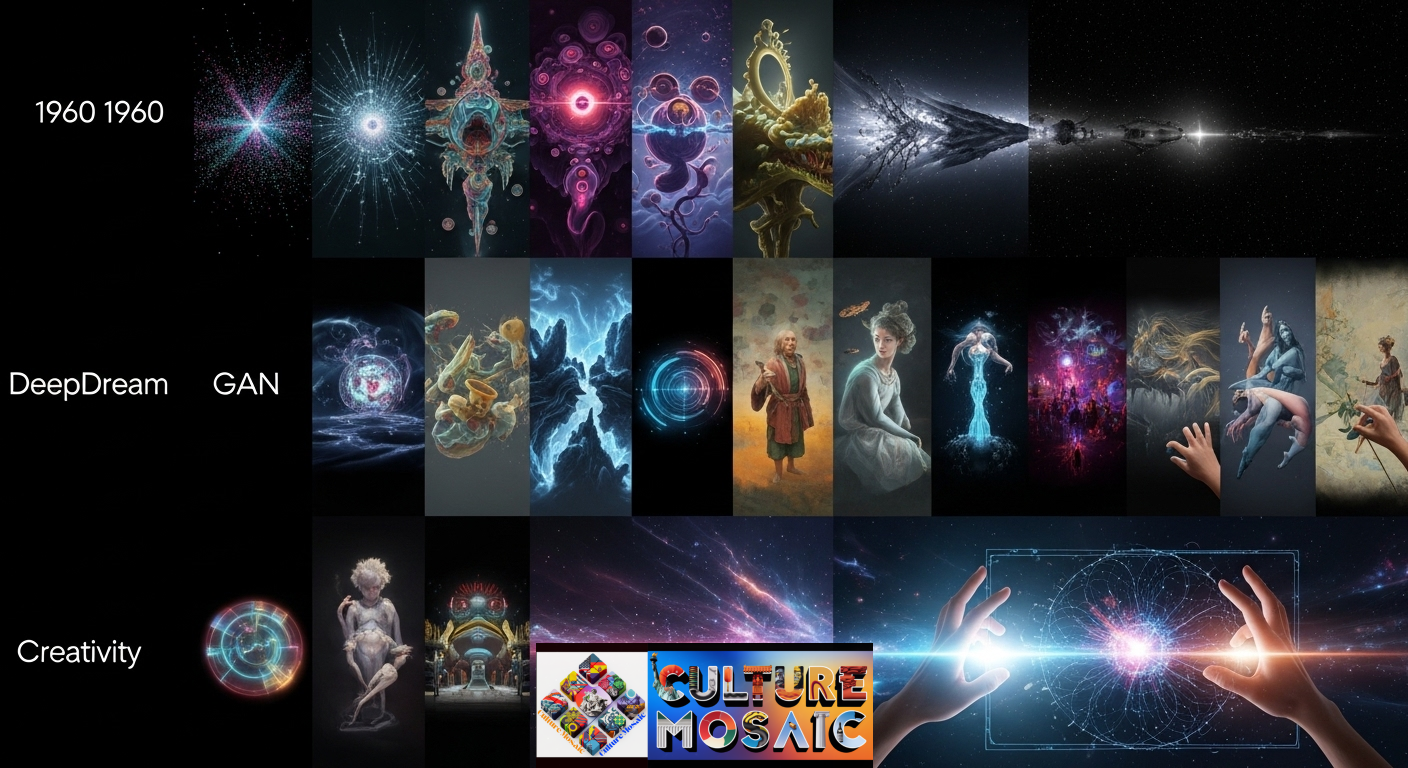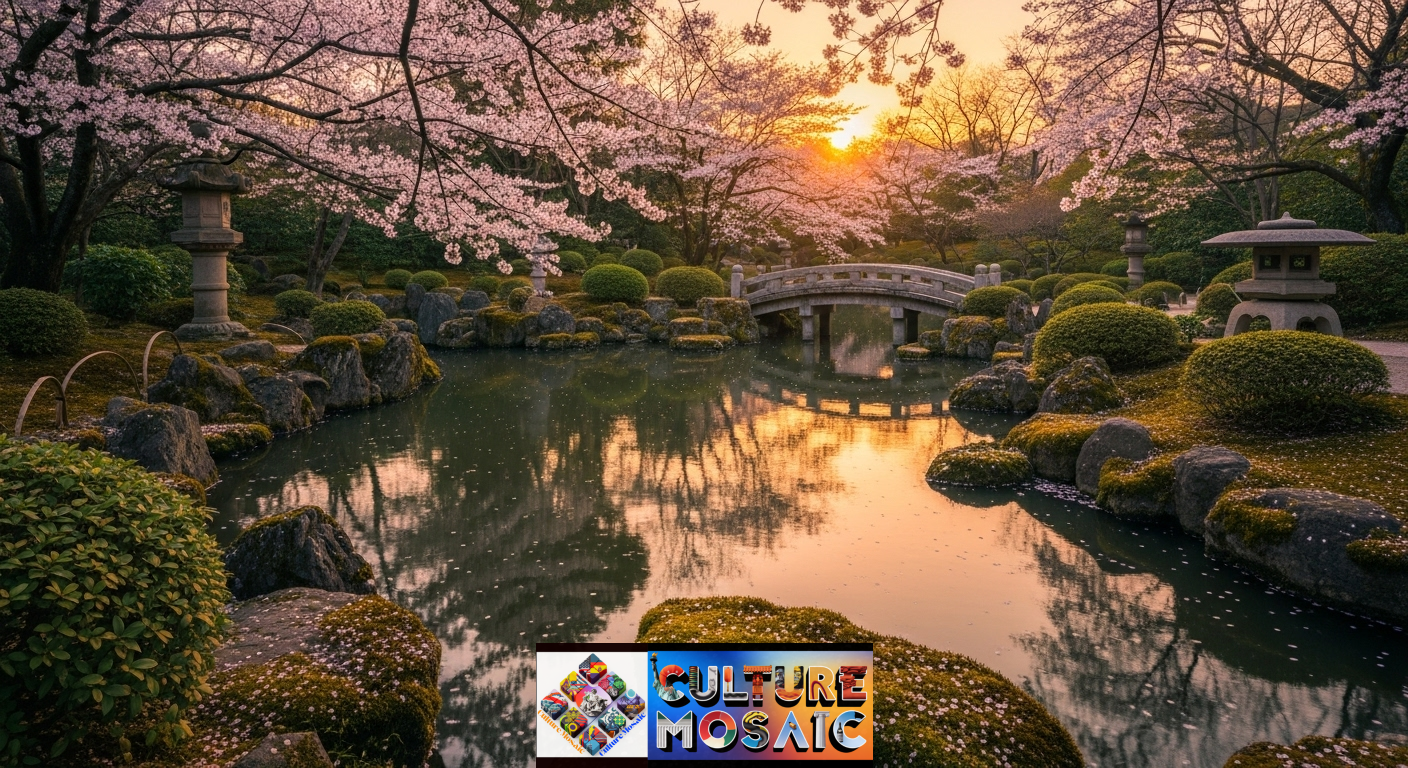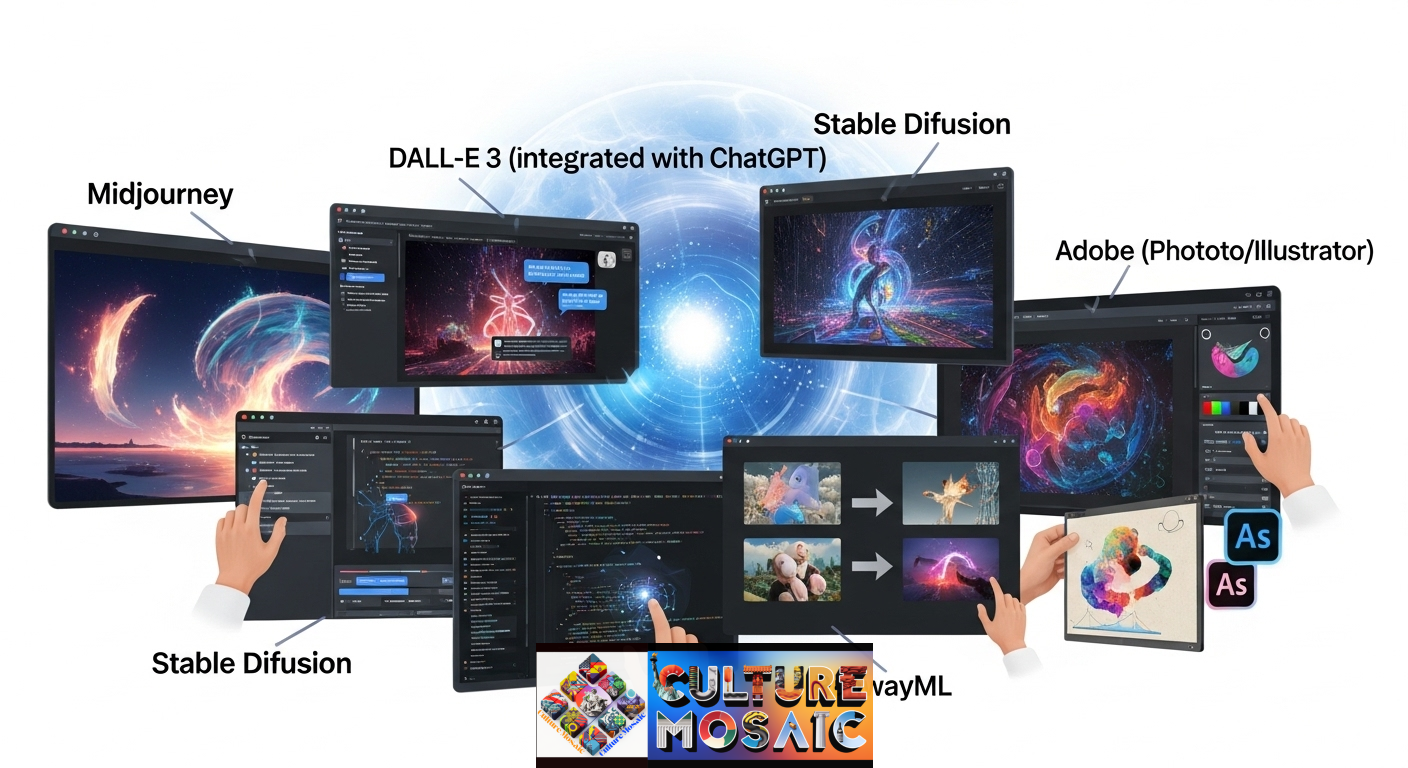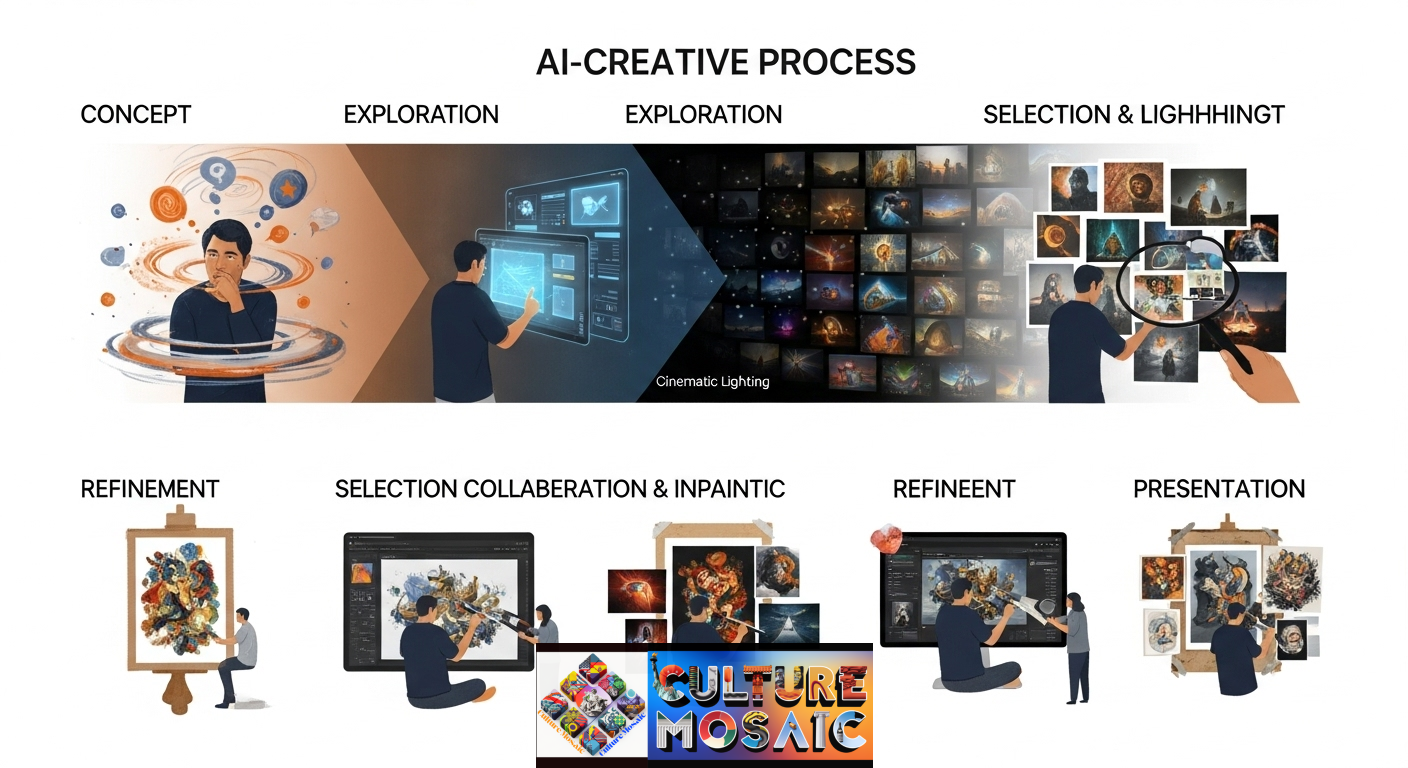The art world is experiencing a seismic shift. AI-collaborative art has emerged as one of the most discussed and debated forms of creative expression in recent years. This isn’t about robots replacing artists. It’s about a new partnership between human creativity and machine intelligence that’s opening doors we didn’t even know existed.
If you’ve scrolled through social media lately, you’ve probably seen stunning images tagged with “AI-generated” or “made with Midjourney.” But here’s what most people miss: the best AI-collaborative art isn’t just machine output. It’s a genuine collaboration where human vision guides artificial intelligence to create something neither could achieve alone.
What is AI-Collaborative Art?
AI-collaborative art represents a partnership between human artists and artificial intelligence systems. Unlike purely AI-generated images that might lack intentionality, collaborative work involves artists actively directing, curating, and refining AI outputs to match their creative vision.
Think of it like this: a painter doesn’t just squeeze tubes of paint onto a canvas and call it done. They select colors, plan compositions, and make thousands of micro-decisions. AI-collaborative art works the same way. The artist provides creative direction through prompts, selects promising outputs, and often combines AI elements with traditional techniques.
The process typically involves generative AI tools like DALL-E, Midjourney, Stable Diffusion, or RunwayML. These platforms use machine learning models trained on millions of images to generate new visuals based on text descriptions. But the magic happens when a skilled artist knows how to communicate with these tools and refine their outputs into something meaningful.
The Evolution of AI-Collaborative Art

This creative partnership didn’t appear overnight. AI-collaborative art has roots stretching back decades, though recent advances have accelerated its growth exponentially.
Early experiments in computer-generated art date to the 1960s, when pioneers like Frieder Nake and Harold Cohen explored algorithmic creativity. Cohen’s AARON program, created in 1973, could generate original drawings based on programmed rules. But these early systems lacked the sophistication we see today.
The real breakthrough came with deep learning and neural networks. In 2015, Google’s DeepDream created surreal, psychedelic images that captured public imagination. Then came Generative Adversarial Networks (GANs), which pitted two AI systems against each other to create increasingly realistic images.
By 2021, the landscape had changed completely. OpenAI released DALL-E, demonstrating that AI could understand complex text prompts and generate corresponding images. Midjourney launched in 2022, quickly becoming a favorite among digital artists. Suddenly, AI-collaborative art wasn’t just possible. It was accessible to anyone with an internet connection.
Today, we’re seeing AI-collaborative art in galleries, museums, and commercial applications. Christie’s auction house sold an AI-assisted artwork for $432,500 in 2018. Major brands use AI-collaborative art for advertising campaigns. Independent artists are building entire portfolios around this hybrid approach.
How AI-Collaborative Art Actually Works

The technical side of AI-collaborative art might sound complicated, but the basic concept is surprisingly straightforward. Most modern systems use diffusion models or transformer architectures trained on vast datasets of images and their descriptions.
When you enter a prompt like “a serene Japanese garden at sunset with cherry blossoms,” the AI doesn’t search a database for matching images. Instead, it generates entirely new pixels based on patterns it learned during training. It understands relationships between concepts: gardens have plants, sunsets have warm colors, and cherry blossoms appear in specific seasons.
Professional artists working in AI-collaborative art develop sophisticated prompting techniques. They learn which keywords produce desired effects, how to reference artistic styles, and how to control composition. A beginner might write “cool dragon.” An experienced practitioner writes “highly detailed emerald dragon perched on obsidian cliff, dramatic backlighting, concept art style, octane render.”
But prompting is just the beginning. Many artists generate dozens or hundreds of variations, selecting the most promising candidates. They might use image editing software to combine elements from multiple AI outputs. Some paint over AI-generated bases. Others use AI to create textures or backgrounds that they incorporate into traditional paintings.
Advanced techniques include inpainting (modifying specific regions of an image), outpainting (extending an image beyond its original borders), and using control networks that guide composition through sketches or poses. The creative possibilities multiply when you understand these tools deeply.
The Tools Shaping AI-Collaborative Art

The AI-collaborative art ecosystem includes several major platforms, each with distinct strengths and communities.
Midjourney operates through Discord and is known for producing aesthetically polished, often painterly results. Its community-driven approach means you can learn from others’ prompts in real-time. The platform excels at creating atmospheric, evocative imagery that feels intentionally artistic.
DALL-E 3, integrated with ChatGPT, offers precise prompt interpretation and strong coherence. It’s particularly good at understanding spatial relationships and generating text within images. The safety filters are more restrictive, but the results are consistently high quality.
Stable Diffusion runs open-source, meaning tech-savvy artists can install it locally and train custom models. This flexibility makes it popular for specialized applications. Want to create AI-collaborative art in your signature style? Train a model on your existing work.
RunwayML focuses on video and motion, expanding AI-collaborative art beyond static images. Artists can generate short video clips, animate still images, or remove objects from footage. Adobe has also integrated AI tools directly into Photoshop and Illustrator, making the technology accessible within familiar workflows.
Each platform has limitations. AI struggles with hands, complex text, and maintaining consistency across multiple images. Understanding these weaknesses helps artists work around them, often combining AI outputs with manual corrections.
The Creative Process Behind AI-Collaborative Art

Creating meaningful AI-collaborative art requires more than typing a few words and hitting generate. Successful artists develop systematic workflows that balance experimentation with intentionality.
The process often starts with concept development. What emotion or idea are you exploring? What story are you telling? AI-collaborative art works best when guided by a clear artistic vision. You’re not just fishing for pretty images. You’re trying to manifest something specific from your imagination.
Next comes the exploration phase. Artists generate variations, testing different prompts and parameters. This is where experience matters. Knowing that adding “cinematic lighting” creates drama or that mentioning specific artists’ names influences style helps you move closer to your vision faster.
Selection and curation separate good AI-collaborative art from mediocre output. Not every generation succeeds. Professional artists might keep five images from a batch of one hundred. They’re looking for compositions that work, emotional resonance, and technical quality.
Refinement is where collaboration becomes explicit. Maybe the AI nailed the overall composition but messed up a crucial detail. Artists might regenerate just that section using inpainting. They might combine the best elements from multiple outputs. Some add hand-painted details or photographic elements.
Final presentation matters too. AI-collaborative art can be printed on traditional media, displayed on digital canvases, incorporated into motion graphics, or used as elements in larger mixed-media pieces. The delivery format affects both the creative decisions and the audience’s perception.
AI-Collaborative Art in Professional Practice
The commercial applications of AI-collaborative art are exploding across industries. Concept artists use AI to rapidly prototype ideas for films and video games. What used to take hours of sketching can now happen in minutes, allowing more iteration and exploration.
Advertising agencies incorporate AI-collaborative art into campaigns. The technology enables rapid testing of visual directions and customization for different markets. A single creative concept can be adapted into dozens of variations with minimal additional cost.
Book publishers use AI-collaborative art for covers, though this remains controversial in some circles. Indie authors and small presses, previously unable to afford professional illustration, now have access to striking visuals. The debate centers on whether this democratizes publishing or undercuts illustrators’ livelihoods.
Fashion designers experiment with AI-generated patterns and textile designs. Interior designers visualize spaces with AI-collaborative art. Architects use it for presentation renderings and conceptual explorations. The technology has found applications wherever visual communication matters.
Some artists build entire careers around AI-collaborative art, selling prints, accepting commissions, and teaching workshops. Platforms like Patreon and Gumroad enable them to monetize their expertise in prompting and curation. The market is still finding equilibrium, but demand clearly exists.
The Controversy Surrounding AI-Collaborative Art
No discussion of AI-collaborative art would be complete without addressing the heated debates it generates. These conversations touch on fundamental questions about creativity, ownership, and economic justice.
The most persistent criticism involves training data. Most AI models are learned by analyzing millions of images scraped from the internet, including copyrighted artwork posted by living artists. Many illustrators discovered their work was included in training datasets without permission or compensation. This feels, understandably, like theft.
Proponents argue this is no different from how human artists learn by studying others’ work. We don’t consider it theft when an artist practices by copying masters or develops a style influenced by their favorites. But critics counter that AI systems don’t “learn” like humans. They perform statistical analysis at scale, which may constitute a different kind of use.
The economic impact worries many professional artists. If clients can generate “good enough” images with AI, why hire a human illustrator? Early evidence is mixed. Some entry-level illustration work has shifted to AI-collaborative art. But demand for distinctive, high-quality human work remains strong. Many successful artists are incorporating AI into their practice rather than being replaced by it.
Questions about authorship and copyright complicate matters further. If an AI generates an image based on your prompt, who owns it? Current US copyright law suggests AI outputs might not be copyrightable since they lack human authorship. But what if you extensively modify the AI output? Legal frameworks are still catching up.
The environmental cost is another concern. Training large AI models requires enormous computational power, which means significant energy consumption. Each generation also uses electricity. As AI-collaborative art becomes more common, its carbon footprint grows.
Intelligent NFTs and the Future of AI-Collaborative Art
One of the most fascinating developments in AI-collaborative art is the emergence of intelligent NFTs, or iNFTs. Traditional NFTs are static digital assets recorded on a blockchain. Intelligent NFTs incorporate AI that allows the artwork to evolve.
Imagine owning a digital portrait that ages as you do, or a landscape that changes with real-world weather patterns. iNFTs can respond to external data, owner interactions, or internal algorithmic processes. This creates a living artwork that never looks the same twice.
The technology behind iNFTs combines smart contracts with AI models. The blockchain stores ownership records and rules governing how the artwork can change. The AI component generates variations while maintaining recognizable characteristics. Some iNFTs even have personalities, responding to messages or “learning” from their owners.
This represents a new frontier in AI-collaborative art. The collaboration extends beyond creation into the artwork’s entire lifespan. The artist sets initial parameters and rules, but the piece develops autonomously afterward. It’s like planting a seed and watching something grow, knowing roughly what to expect but never quite certain of the exact outcome.
Early experiments with iNFTs have shown both promise and limitations. The technology is complex and expensive to implement. Storage costs for dynamic, generative art can be prohibitive. But as infrastructure improves, we’ll likely see more artists exploring this space.
Practical Tips for Creating AI-Collaborative Art
If you’re interested in creating your own AI-collaborative art, start with the fundamentals. Choose a platform based on your needs and budget. Midjourney offers a good balance of quality and ease of use. Stable Diffusion provides more control if you’re technically inclined.
Learn the language of prompting. Study successful prompts shared by others. Notice patterns in keywords that produce desired effects. Terms like “volumetric lighting,” “depth of field,” and “bokeh” create photographic qualities. Mentioning artistic movements like “impressionist” or “art nouveau” influences style. Referencing specific artists can guide aesthetic direction, though this remains ethically contentious.
Start with clear concepts rather than vague ideas. “Interesting fantasy scene” produces mediocre results. “Ancient wizard’s library with floating books, warm candlelight, leather-bound grimoires, mysterious artifacts on shelves, magical atmosphere” gives the AI much more to work with.
Generate in batches and embrace iteration. Your first attempt rarely nails exactly what you want. Create variations, identify what works, then refine your prompt based on those insights. This iterative approach is fundamental to effective AI-collaborative art.
Don’t rely solely on AI output. The best AI-collaborative art often involves human refinement. Learn basic image editing. Combine elements from multiple generations. Paint over or digitally enhance the results. The collaboration works both ways.
Study composition, color theory, and artistic principles. AI tools don’t replace artistic knowledge. They amplify it. Understanding why certain compositions work helps you guide the AI more effectively and recognize strong results when they appear.
Consider the ethical implications of your practice. Avoid generating work in the exact style of living artists without permission. Be transparent about your process when sharing or selling AI-collaborative art. Support efforts to create more ethically trained models.
The Human Element in AI-Collaborative Art
Despite all the technology, AI-collaborative art ultimately depends on human creativity, judgment, and intention. The AI is a tool, not the artist. This distinction matters more than it might seem.
When photographers emerged in the 19th century, critics argued photography couldn’t be art because machines did the work. We now recognize that great photography requires artistic vision, technical skill, and countless creative decisions. The camera is a tool in the service of human expression.
AI-collaborative art works the same way. The artist chooses what to create, how to prompt the system, which outputs to keep, and how to refine results. These decisions reflect taste, experience, cultural context, and personal vision. The machine executes instructions, but it doesn’t have intentions or emotions.
Consider the difference between typing “sad portrait” into an AI and spending hours developing a concept for an image that explores grief in a specific, nuanced way. Both use the same technology, but only one demonstrates artistic practice. AI-collaborative art created thoughtfully with a clear creative vision differs fundamentally from random generation.
The best practitioners of AI-collaborative art bring the same dedication to their craft as traditional artists. They develop signature styles, explore consistent themes, and refine their technical skills over time. They think deeply about what they’re making and why it matters.
Where AI-Collaborative Art Goes Next
The technology driving AI-collaborative art continues evolving rapidly. Near-term developments will likely focus on better prompt understanding, improved consistency across generations, and more sophisticated control mechanisms.
Video generation is improving quickly. Current tools can create short clips, but they struggle with longer narratives and maintaining character consistency. As these limitations dissolve, AI-collaborative art will expand into animation and filmmaking.
Three-dimensional modeling represents another frontier. Imagine describing a 3D object and having AI generate a printable model or a character ready for game engines. Early experiments show promise, but the technology needs refinement.
Personalization will become more sophisticated. AI models that learn your aesthetic preferences and creative style could become true collaborative partners, anticipating your intentions and offering relevant suggestions.
The ethical and legal frameworks around AI-collaborative art will mature. We’ll likely see new licensing models, attribution systems, and potentially AI models trained exclusively on properly licensed content. Organizations are already exploring opt-in datasets where artists contribute work voluntarily in exchange for compensation or credit.
Education will play a crucial role. As AI-collaborative art becomes mainstream, schools and workshops will teach it alongside traditional techniques. The next generation of artists will grow up with these tools, developing practices we haven’t yet imagined.
AI-Collaborative Art and Traditional Techniques
One exciting direction involves combining AI-collaborative art with traditional media. Artists are printing AI-generated designs onto canvas and painting over them. Others use AI to generate bases or backgrounds, then add hand-drawn or painted elements.
This hybrid approach addresses some criticisms of purely digital AI work. It reintroduces the physical craft and unique materiality that traditional art provides. Each piece becomes one-of-a-kind, with human touches that distinguish it from pure AI output.
Some artists use AI-collaborative art for planning and composition, much like Renaissance artists used preparatory sketches. Generate multiple compositions with AI, select the strongest, then recreate it traditionally. The AI serves as a brainstorming partner and visual reference.
Sculptors are experimenting with AI-generated forms translated into physical objects. The AI might suggest organic shapes or patterns that the artist then carves, casts, or 3D prints. This extends AI-collaborative art into three-dimensional space in tangible ways.
Textile artists and designers use AI to generate patterns for weaving, embroidery, or printing. The intersection of algorithmic design and traditional craft creates fascinating results that honor both technological innovation and historical techniques.
The Psychology of Creating with AI
Working with AI changes the creative experience in subtle but significant ways. Traditional art involves direct manipulation. Your hand moves the brush, chisels the stone, or shapes the clay. There’s immediate tactile feedback and complete control.
AI-collaborative art introduces indirection and surprise. You describe what you want, but the result comes from a system you don’t fully control. Sometimes it produces exactly what you envisioned. Other times, it offers unexpected alternatives that change your direction entirely.
This unpredictability can be frustrating or liberating, depending on your temperament and approach. Some artists love the element of chance, finding inspiration in AI’s unexpected interpretations. Others prefer the precise control of traditional methods.
The iterative nature of AI-collaborative art can be addictive. It’s easy to lose hours generating variations, always thinking the next one might be perfect. Successful practitioners develop discipline around when to stop generating and start refining.
There’s also a question of ownership and pride. Does AI-collaborative art feel as personally meaningful as something you created entirely by hand? Most artists who embrace the medium report that yes, it does, because their creative vision and curation define the work. But this varies individually.
Building a Career in AI-Collaborative Art
For artists considering AI-collaborative art professionally, several paths are emerging. Some focus on commission work, creating custom pieces for clients who want specific concepts visualized. Others build audiences on social media, monetizing through print sales, NFTs, or Patreon support.
Education and consulting represent growing opportunities. As more people want to learn AI-collaborative art, workshops, courses, and one-on-one coaching have become viable income streams. Teaching what you know can be as profitable as creating art itself.
Some artists partner with brands or agencies, serving as AI art directors or consultants. They help companies navigate the technology and create effective visual content. This combines creative work with strategic thinking about how AI fits business needs.
Building a distinctive style is crucial for standing out. Since anyone can access the same AI tools, differentiation comes from how you use them. Develop signature approaches to prompting, curation, or post-processing that make your work immediately recognizable.
Transparency about the process helps build trust with audiences. Many successful AI-collaborative artists openly discuss their techniques, including both AI and traditional elements. This honesty resonates with audiences and helps navigate the ethical debates surrounding the medium.
The Global Impact of AI-Collaborative Art
AI-collaborative art is democratizing visual creativity in unprecedented ways. Someone in a remote village with internet access has tools once available only to those who could afford art school and expensive materials. This geographical leveling is powerful.
Language barriers diminish when visual creativity becomes more accessible. AI tools work across languages, allowing artists worldwide to participate in global conversations through imagery. This could diversify whose voices and perspectives shape visual culture.
However, access remains uneven. AI-collaborative art requires reliable internet, capable devices, and often subscription costs. Communities without these resources remain excluded. As the technology matures, addressing these disparities will be important for ensuring AI-collaborative art truly democratizes creativity.
Cultural representation in training data is another consideration. If AI models learn primarily from Western art, they’ll naturally default to Western aesthetics and perspectives. Efforts to create more culturally diverse training datasets could help AI-collaborative art reflect global creative traditions more authentically.
The technology is already influencing how visual trends spread globally. Styles that might have taken years to disseminate through traditional art channels can now go viral within days through AI-collaborative art communities. This accelerates cultural exchange but also risks homogenization.
Conclusion
AI-collaborative art represents more than a new set of tools. It’s reshaping our understanding of creativity, collaboration, and what it means to be an artist. Like every major technological shift in art history, from oil paints to photography to digital editing, it’s generating both excitement and anxiety.
The future of AI-collaborative art isn’t predetermined. It depends on the choices we make now about ethics, education, and how we integrate this technology into creative practice. Used thoughtfully, AI can expand human creativity and make artistic expression more accessible. Used carelessly, it could perpetuate biases, undermine artists’ livelihoods, and produce an ocean of meaningless content.
What’s certain is that AI-collaborative art is here to stay. The technology will improve. More people will adopt it. New applications will emerge. The most successful artists will be those who embrace the collaborative potential while maintaining strong creative vision and ethical awareness.
This is an incredible moment to engage with AI-collaborative art, whether as a creator, collector, or simply someone curious about where creativity is heading. The conversation is just beginning, and you have an opportunity to shape it. Jump in, experiment, ask questions, and remember that the most important element in AI-collaborative art will always be human: your imagination, your choices, and your voice.
Frequently Asked Questions About AI-Collaborative Art
Is AI-collaborative art real art?
Yes, AI-collaborative art is real art when created with intentionality and creative vision. The AI is a tool, like a camera or paintbrush. What makes something art isn’t the tool you use but the human decisions, emotions, and ideas you express through it. The debate mirrors historical arguments about whether photography or digital art was “real” art. Quality AI-collaborative art involves substantial human creativity in concept development, prompting, curation, and refinement.
Can I sell AI-collaborative art legally?
The legal landscape is still developing. Most AI platforms’ terms of service grant you rights to commercial use of images you generate. However, copyright protection for AI outputs remains uncertain under current US law. Many artists sell AI-collaborative art successfully, especially when they add significant human modifications. Transparency about your process is advisable, and consulting a legal professional familiar with intellectual property in your jurisdiction is recommended for serious commercial work.
Do I need artistic training to create good AI-collaborative art?
Artistic training helps tremendously, but isn’t strictly required. Understanding composition, color theory, lighting, and artistic movements makes you much more effective at prompting AI and recognizing strong results. However, people without formal training can create compelling AI-collaborative art through experimentation and learning. The technology lowers the technical barriers while still rewarding artistic knowledge and taste. Many successful AI artists are self-taught, learning through practice and studying others’ work.
How is AI-collaborative art different from just typing prompts into an AI?
The difference lies in intentionality and refinement. Simply typing random prompts and keeping whatever appears is more like stumbling upon interesting images than creating art. AI-collaborative art involves developing clear concepts, systematically refining prompts, generating many variations, carefully selecting the best results, and often combining AI outputs with human modifications. Professional practitioners spend hours on single pieces, making countless creative decisions. The collaborative aspect means working with the AI iteratively, not just using it as a one-click solution.
Will AI replace human artists?
AI is changing the art industry, but it likely won’t replace human artists entirely. Certain types of commercial work are shifting toward AI, particularly generic stock imagery and some entry-level illustration. However, demand remains strong for distinctive creative vision, emotional depth, and the unique perspectives only humans provide. Many artists are successfully incorporating AI as one tool among many rather than being replaced by it. The future probably involves AI and humans working together in different configurations rather than simple replacement. Artists who adapt and develop strong creative voices will continue finding audiences and opportunities.

